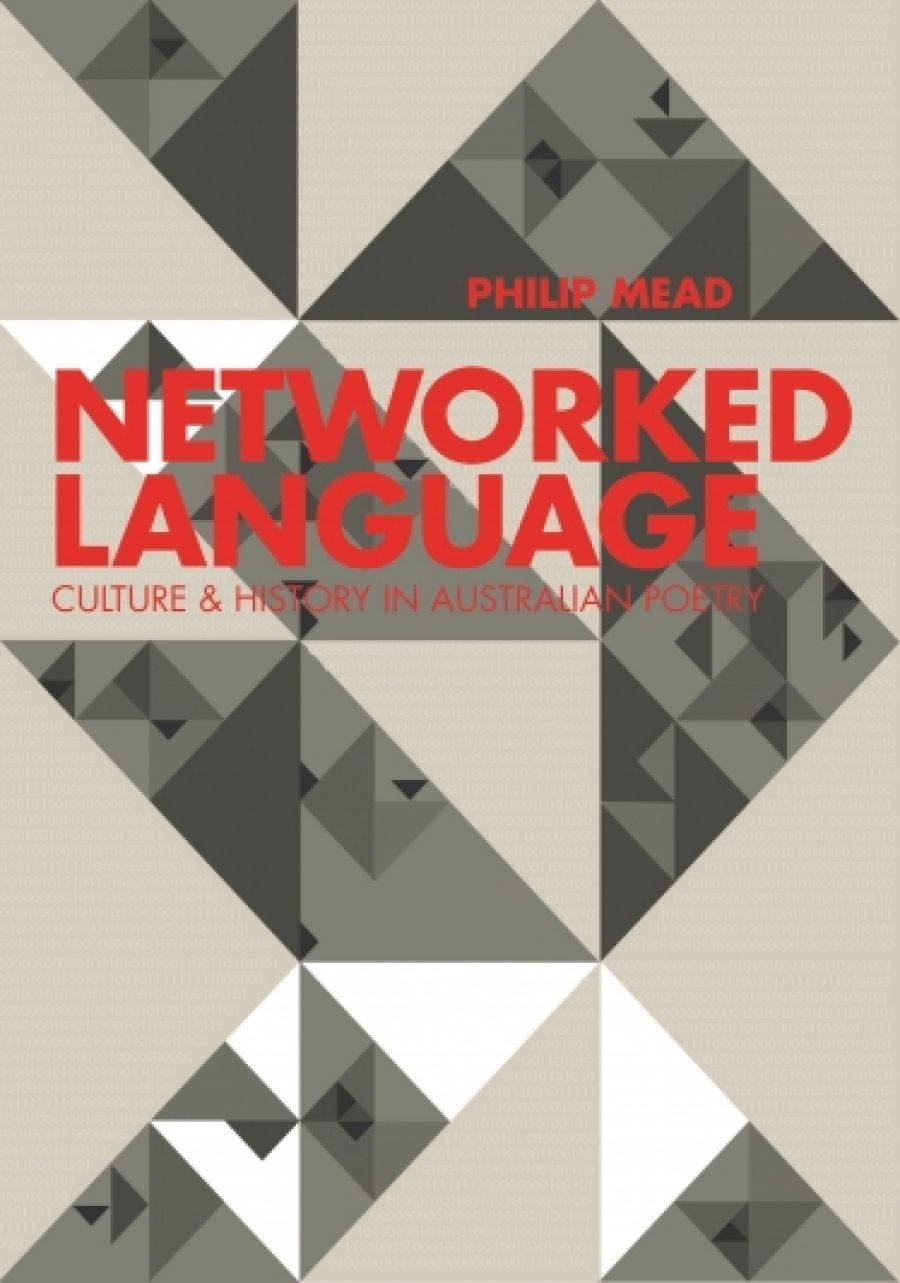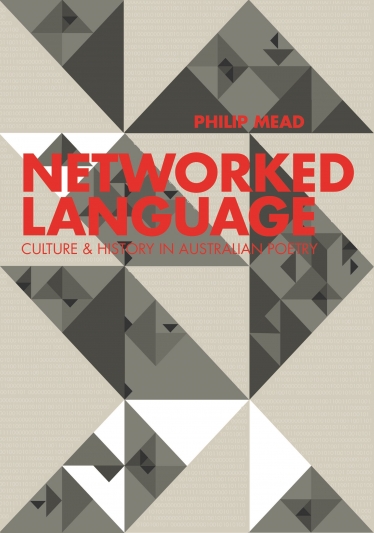
- Free Article: No
- Custom Article Title: Networked networks
- Review Article: Yes
- Article Title: Networked networks
- Online Only: No
- Custom Highlight Text:
Philip mead’s Networked Language: Culture & History in Australian Poetry is an extraordinary piece of scholarly writing: large, ambitious, meticulously researched, brilliantly written and quite original. It is laudable not only for these inherent virtues but also, it has to be said, because of its very existence. Australian Scholarly Publishing is to be commended for publishing such a work. If poetry is marginal to Australian public culture (as we are routinely told), then works about Australian poetry are all but invisible. It is all the more notable, then, that Mead’s work should join another recently published, large-scale work on modern Australian poetry: Ann Vickery’s Stressing the Modern: Cultural Politics in Australian Women’s Poetry, published by Salt in 2007. Both Mead’s and Vickery’s books use Australian poetry as a way of intervening in, or instigating, debates in modern politico-cultural history. (And to these studies we may also add another ambitious piece of poetry criticism, John Kinsella’s more globally focused Disclosed Poetics: Beyond Landscape and Lyricism, Manchester University Press, 2007.)
- Book 1 Title: Networked Language
- Book 1 Subtitle: Culture & history in Australian poetry
- Book 1 Biblio: Australian Scholarly Publishing, $39.95 pb, 540 pp, 9781740971973
- Book 1 Cover Small (400 x 600):

- Book 1 Cover (800 x 1200):

Mead’s work is an instance of exactly the kind of outstanding contemporary criticism that he saw in Vickery’s study, which he described, in endorsing the book, as ‘a brilliant blend of original archival research, in-depth contextualisation of the poetry, and authoritative biographical framing’ of the writers’ extra-poetic lives. The extensive research upon which Networked Language rests also illustrates the internationalisation of Australian literary studies that commentators such as Robert Dixon have recently been recognising and advocating. For Mead, ‘Australian poetry’ is not a category that is merely nationalist in orientation or constitution. Rather, it is a category that allows a way of reading diverse forms of poetry (the ‘networked language’ of the title) within countless other networks that exceed simple nationalist discourses. Indeed, as Mead writes, focusing on the sociolinguistic history of his chosen poems, rather than trying to fit them into a nationalist narrative of literary history, ‘inevitably turns out to mean discovering poetry’s unsettling critique of rhetorics of nation and identity’.
By focusing on the specificity of his chosen poems, Mead situates those poems within rich political and historical contexts that are generally ignored in nationalist literary histories. These contexts include European modernism (from Dada to Fluxus), Egyptomania of the 1920s, colonial architecture, Shakespeare, ‘digital’ poetry, the writings of Oulipo and Language Poetry, communications theory, psycho-analytic theory and film studies. (Perhaps not surprisingly, the book’s endnotes take up eighty-one pages.) In addition to showing himself to be the master of numerous bodies of critical literature, Mead also shows his considerable skill in archival research.
The methodological importance of these contexts (historical and archival) is made clear from the beginning of Networked Language with the assertion that Mead’s interest is in ‘the network of relations between some examples of Australian poetic creativity, the broader poetic field as a plane of culture, and the social history of that most renewable of resources, language’. As Mead states, such a ‘contextualist’ project is, in itself, an unsurprising one in contemporary literary studies (‘who,’ he asks ‘would now argue for the autonomous meaning of any art object, as desirable or actual?’). But as Mead points out, there is little consensus about what such a critical orientation signifies in terms of understanding how poetic meanings are generated. And more often than not in the Australian context, ‘the intellectual task of explicating the involution of poetry and poetics in the strata of (national) history and locational culture is not pursued’. Mead’s originality, then, lies in the many insights produced in trying to read how poetic language operates in complex cultural and historical networks.
Such an approach is consistent with Mead’s intense interest in the unseen, the ignored and the critically marginalised in Australian poetry. For instance, Mead concentrates on the completely overlooked fact that Kenneth Slessor, Australia’s premier modernist poet, worked for many years as a film critic. (The strength of Mead’s reading can be judged by noting the shock that one subsequently feels that this feature of Slessor’s journalistic life has previously been ignored.) Mead also considers, to a degree not previously attempted, the importance of Shakespeare, both inter- and intratextually, in the ‘Ern Malley’ hoax. By considering such things, Mead discovers previously unseen connections, procedures and conditions in modern and postmodern Australian poetry. These include an understanding of the ‘cinematism’ of Slessor’s poetry, and the ironic – and scandalous – discovery that Malley could be, like Shakespeare, a kind of national poet.
Mead’s choices of ‘Australian poetic creativity’ are necessarily limited in number, but they cover considerable theoretical ground. In addition to Slessor and Malley, the book’s six chapters cover the ‘Voyager’ poems of the mid twentieth century and the ambivalent place of the Portuguese navigator Ferdinand de Quiros in Australian history; Judith Wright’s ‘unassimilable’ role as both poet and political activist (an attempt to account for her social role without discounting her poetic work); the development of ‘digital’ poetry, looking especially at the computer-generated poetry of John Tranter; and the political implications of the ‘hybridised’ voices of Lionel Fogarty, a ‘first-nation’ Australian, and ∏O, a Macedonian-born Australian.
One of the notable things about Mead’s study, necessarily devoid of an overarching narrative, is how the chapters deal with the relationship between ‘aesthetic’ and ‘political’ concerns (while at no point positing such a bald opposition): Slessor’s cinematic aesthetic, and the putting on trial of poetic language in the ‘Ern Malley’ case; the seductive postmodern pleasure of a digital recombination of language, and the unsettling critique of the hybrid languages of Fogarty and ∏O, who work outside the (colonising) sovereignty of Australian English. In the middle chapters, the aesthetic/political dyad is most clearly articulated. In the case of the chapter on McAuley’s Captain Quiros and the Voyager poems, Mead shows the unexpected, and complex, interactions between poetic creativity and the political history of Papua New Guinea. In his chapter on Wright, his emphasis on the metaphor of ‘the edge’ allows a way of accounting for both Wright’s poetic work and her political activism, without discounting either.
In bringing together the ‘poetic’ and the ‘unpoetic’ (whether that is early film criticism, court records or political autobiography), Mead adds immeasurably to our understanding of both the poetry in question and its various contexts. In particular, his chapter on Fogarty and ∏O shows how important the works of these relatively ignored poets are to an understanding of the political implications of the monolingual condition of Australian national identity.
This is a big book by a small publisher, so it is perhaps inevitable, if a little regrettable, that there are some minor errors throughout the work (problems with quote marks, missing italics and so on). I also struggled at times with the link between the text and its given footnote (Mead having a tendency to allow the link between text and citation to speak for itself). But these are minor quibbles about a superb book.
Mead has long been a notable figure in Australian literary studies. In addition to publishing fine criticism and poetry, he has edited numerous works, has co-edited (with John Tranter) The Penguin Book of Modern Australian Poetry (1991), has been poetry editor of Meanjin, is co-editor of the scholarly journal JASAL, and is closely involved in the AustLit database. Networked Language, Mead’s latest addition to Australian literary studies, is a monumental and original work, and one that will surely be read by scholars for many years to come.


Comments powered by CComment